Discovering Pallasite Peridot: Science Meets Art
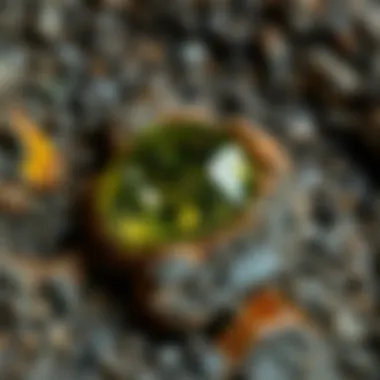
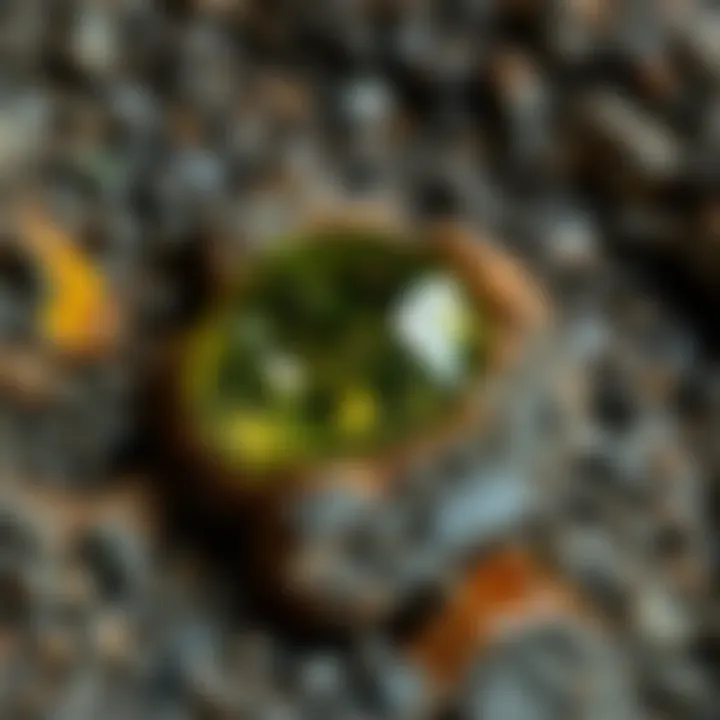
Intro
Pallasite peridot, a dazzling gem encased in metallic meteorites, beckons both scientists and enthusiasts alike. This intriguing mineral not only offers a window into the processes of the cosmos but also serves as a tantalizing collectible for those who appreciate its rare beauty. In this exploration, we embark on a journey to uncover the history, classification, and aesthetic allure of this remarkable gemstone. By the end, readers will not only grasp the geological narratives woven into each piece of pallasite but also appreciate its significance in the realms of meteoritics and personal collections.
History and Origins
Overview of Collectibles, Rocks, and Fossils
Pallasite peridot is distinct, being one of the rarest gemstones derived from space. It typically forms within the cores of differentiated asteroids, where intense heat and pressure allow olivine crystals to crystallize alongside nickel-iron. The discovery of these meteorites can date back to the 19th century, and they often pique the curiosity of geologists and collectors caught between science and aesthetic appreciation. The intriguing deep green hue of the peridot, set against the darker, metallic matrix, creates a visual delight, making it highly desirable among collectors of rocks and fossils.
Historical Significance and Cultural Impact
Pallasite meteorites have unique stories, often linked with significant cultural and scientific milestones. For example, the autumn of 1868 marked the discovery of the first recognized pallasite, the Krasnojarsk meteorite in Siberia. This meteorite opened a door to a deeper understanding of planetary formation and astrobiology, considerably enriching humanity's grasp of its place in the universe. Additionally, these meteorites have sparked myths and legends across cultures, purportedly symbolizing divine blessings or celestial watchfulness.
Identification and Classification
Guide to Identifying Pallasite Peridot
Identifying a piece of pallasite peridot amongst various meteorite types requires keen observation. Collectors often look for:
- Color: A bright, vibrant green indicative of peridot inclusions.
- Matrix: A mix of nickel-iron, usually exhibiting a metallic sheen.
- Crystal Formation: The olivine crystals can appear as translucent grains embedded within the metallic matrix, often giving them an eye-catching appearance.
Common Types and Variations
Various pallasites exhibit unique characteristics based on their origin and the conditions under which they formed. Some notable types include:
- Esquel Meteorite: Known for its outstanding crystal clarity, often regarded as a prime specimen among collectors.
- Brenham Meteorite: Features large peridot crystals, showcasing the stunning visual appeal that captivates collectors.
- Tamarisk Meteorite: Unique for its rich history among Native American lore, this meteorite adds a cultural layer to its geological significance.
"Speaking of pallasites, the balance between beauty and scientific significance is what keeps people returning to these cosmic gems."
Epilogue
This journey into the world of pallasite peridot encapsulates the endurance of human curiosity. By bridging the gap between aesthetics and science, collectors and researchers continue to unravel the stories embedded in meteorites. As this fascination grows, the allure of pallasite peridot remains, inviting further exploration and appreciation.
Prologue to Pallasite Peridot
Pallasite peridot stands at the crossroad of geological marvel and aesthetic wonder, drawing both scientists and collectors into its unique allure. Understanding this extraordinary gemstone is crucial, as it represents not just a piece of Earth's history, but also serves as a testament to the vastness of our universe. This section sets the stage for a comprehensive exploration of pallasite peridot, shedding light on its defining characteristics and the rich historical background that gives this mineral its place in both scientific research and gemology.
Defining Pallasite Peridot
Pallasite peridot is a tantalizing blend of silicate minerals and metal, specifically originating from pallasitic meteorites — remnants of the earliest solar system. The most notable feature of pallasite peridot is its vibrant green color, attributed to the mineral olivine, which forms within the meteorites under immense pressure and heat during their formation. This duality of metallic iron-nickel combined with the minerals creates a stunning contrast that makes it a coveted find among collectors.
Collectors often refer to pallasite peridot as the "jewel of the skies" because of its celestial origins. The sheer beauty of these stones, often glistening and transparent, makes them highly desirable. But beauty aside, the complexity of how these meteorites form presents an intriguing narrative worth consideration. By defining pallasite peridot in this way, it becomes clear that its significance extends far beyond its aesthetic appeal; it is an entryway into understanding the intricate workings of our universe.
Historical Context
The story of pallasite peridot is entwined with the history of meteorology and geology. First discovered in 1836 by the Russian scientist Heinrich Wilhelm Olivine, the mineral has since sparked the interest of not just gem enthusiasts but also those keen on extraterrestrial phenomena. The discovery of pallasite meteorites provides compelling evidence of how asteroids once housed materials that could contribute to planetary formation.
From ancient civilizations to modern science, pallasites have found a place in diverse cultural contexts. In history, some societies believed that meteorites were gifts from the gods, linking them to divine interventions and mystical stories. This mythical angle adds another layer to the understanding of pallasite peridot, as it has inspired not only scientific admiration but also cultural reverence.
The intersection of the mineral’s scientific and aesthetic dimensions allows for a deeper appreciation of its importance, positioning pallasite peridot not just as a gem but as a piece of history forged in the fires of cosmic events. This historical lens will embolden our further investigation into the geological processes that give rise to these extraordinary meteorites.
The Geological Formation of Pallasite


The geological formation of pallasite meteorites is a pivotal aspect of understanding this rare gem, intricately weaving together science and aesthetics. These cosmic treasures are formed through processes that are both complex and breathtaking, taking millions of years to create. Examining the formation of pallasites helps reveal not just the inner workings of our Solar System, but also the geological conditions that contribute to the development of rare minerals like pallasite peridot. By unpacking these details, we enhance our appreciation of the natural beauty and scientific significance locked within every specimen.
Origin of Pallasitic Meteorites
Pallasitic meteorites originate from the core-mantle boundary of differentiated asteroids, remnants from the early Solar System. When an asteroid forms, it progresses into layers, with heavier materials sinking to the core and lighter materials remaining closer to the surface. The exact birthplaces of pallasitic meteorites often lie in these intermediary zones where precious metals and silicate minerals coexist.
When collisions or other disruptive events occur in space, such as the impact of a smaller body striking a larger one, fragments from these differentiated bodies can be ejected into space. These fragments, when they find their way to Earth, are what we classify as pallasitic meteorites. Notably, they are relatively rare—only a few of the thousands of meteorite specimens collected match the pallasite description. This rarity elevates their desirability, especially among collectors and scientists alike.
"Pallasitic meteorites serve as a bridge between the violent processes of cosmic creation and the subtle beauty of mineralogy."
Conditions for Formation
The conditions under which pallasitic meteorites are formed are as fascinating as the meteorites themselves. Several critical factors define the environment required for their creation:
- Temperature and Pressure: The heat and pressure experienced within a massive asteroid must be substantial enough to allow for differentiation. It’s believed that somewhere between 900°C to 1200°C, the metallic and silicate materials begin their dance of separation.
- Material Composition: The specific makeup of the asteroid also notably affects formation. Elements like iron, nickel, and magnesium play significant roles in the development of the characteristic (and visually striking) olivine crystals unique to pallasites. Depending on the asteroid's original composition, the quality and visual appeal of the peridot can vary immensely.
- Cosmic Events: Events such as collisions with other celestial bodies are pivotal in dispersing these meteorites. It's the chaos of these collisions that can thin out the layers and create the fractures that many collectors find alluring.
In summary, the exploration of pallasite peridot and its formation not only offers vital insights into planetary geology but also deepens our fascination with the the intricate narrative echoed in these gems. Understanding where they come from and how they form enhances the appreciation for every celestial stone, making the connection between collectors and their pieces that much more profound.
Physical and Chemical Properties
Understanding the physical and chemical properties of pallasite peridot is crucial for several reasons. Firstly, it helps collectors and enthusiasts appreciate the gem's uniqueness not just as a visual spectacle, but as a story written in elements and compounds. Explorations of these properties provide insights into how pallasite formed and its behaviors in various conditions, thus informing collectors how best to preserve these celestial treasures.
Mineralogical Composition
Pallasite peridot, a combination of olivine and metallic iron-nickel, is a stunning example of nature's artistry. Its mineralogical composition is what sets it apart from standard peridot, which is a gemstone form of olivine. In pallasitic meteorites, the olivine crystals are embedded in a matrix of nickel-rich metal. This unique combination gives pallasite not only its striking aesthetic but also mechanical properties that are vital for its valuation and care.
For instance, the olivine–the most notable component–often displays a rich green color, whereas the metallic surrounding elements contribute to an intriguing visual contrast. Collecting favors specimens where the olivine crystals are larger and clearer, hinting at the concentration of specific minerals within the meteorite.
The chemical formula for olivine is (Mg, Fe)2SiO4. This means the structure can vary depending on the ratio of magnesium to iron. The presence of other trace elements can further impact the color shades present in the gem, ranging from yellow-green to brownish-green hues.
Unique Features of Peridot
The unique features of pallasite peridot make it a fascinating subject of study and an enticing collectible. One major characteristic is its transparency; unlike many gemstones, pallasite crystals often contain inclusions that can create captivating visual effects. When light hits these inclusions, the stones can exhibit a twinkling or shimmering effect, making them a favorite among jewelers and collectors alike.
Furthermore, pallasite is noted for its extreme rarity. Given that it comes from meteorites, collecting this gem is more than just acquiring a pretty piece; it's owning a fragment of space. Most collectors might only hold a few specimens throughout their lifetime, which makes each acquisition special.
The aesthetics are not solely visual; the tactile sensations felt when holding the stone adds another layer of appeal. The weight of pallasitic peridot, thanks to its metallic matrix, gives it a distinctive heaviness compared to terrestrial precious stones, resulting in physical properties that elevate its appeal.
In summary, the physical and chemical properties of pallasite peridot are not just metrics; they are gateways to understanding this extraordinary meteorite mineral.
Join discussions with fellow enthusiasts and professionals on forums like reddit.com or explore through valuable scientific resources like Wikipedia for deeper insights into the remarkable world of pallasite peridot.
The Aesthetic Appeal of Pallasite Peridot
The allure of pallasite peridot lies not just in its scientific significance but also in its remarkable beauty. This section aims to unravel the layers of aesthetic appeal that pallasite peridot presents, emphasizing its vibrant hues and unique characteristics. For both collectors and enthusiasts alike, understanding its aesthetic elements enhances appreciation and informs choices in acquiring such stunning pieces.
Color Variations
Pallasite peridot is distinguished by a palette that ranges from lush greens to muted yellows, often with shimmering crystalline inclusions. The color discrepancies stem from its unique formation process.
- Green Shades: The predominant color is often a rich, olive green, reminiscent of verdant landscapes. This green is partially due to the iron content, which varies from one specimen to another. Some collectors favor the deep green shades, as they seem to radiate energy and vitality.
- Yellow Undertones: Many stones exhibit golden hues, giving them a warm character. This feature can be particularly striking under varying lighting conditions, where the depth of color can dramatically change.
- Dazzling Crystal Inclusions: The olivine crystals in pallasite are shaped uniquely, contributing to the gem's sparkle. When exposed to light, these inclusions refract, casting sparkles that dance around the stone, hence making each piece a conversation starter.
"The colors of pallasite peridot whisper stories of the cosmos, inviting us into their universe with a simple gaze."
Collectors often seek out these vibrant stones, not just as ornaments but as representations of an ancient celestial landscape. The diversity in colors allows for personal expression in jewelry designs, making it a favorite choice for bespoke pieces.
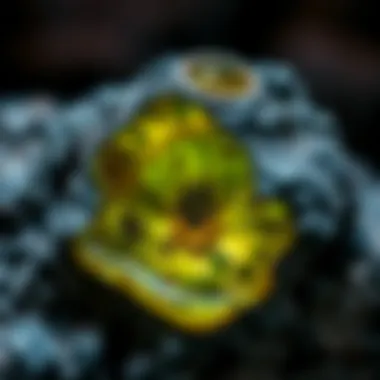
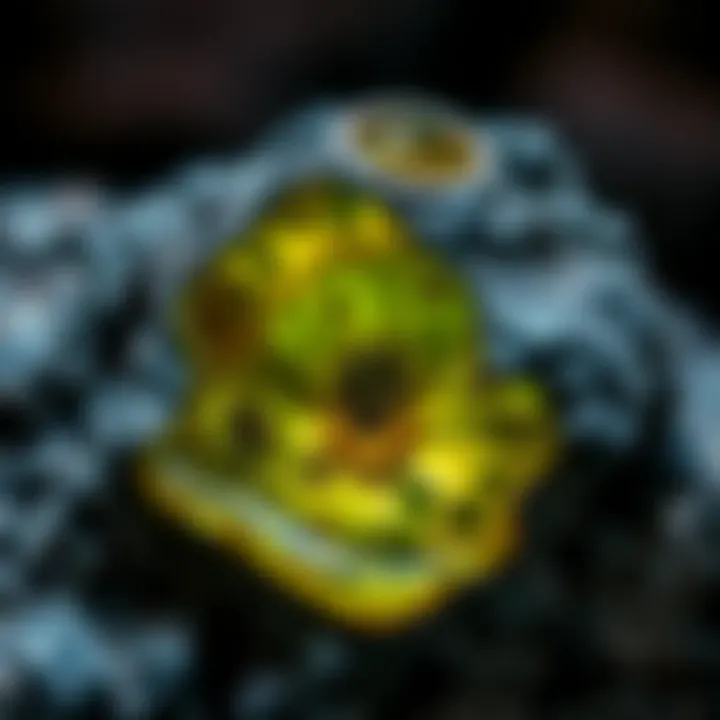
Visual Characteristics
Beyond color, pallasite peridot is characterized by visual elements that enhance its charm.
- Clarity and Transparency: Unlike many gemstones that exhibit opacity, pallasite peridot offers a clarity that is captivating. This transparency allows for a striking view of the internal structures, a testament to its extraterrestrial origin.
- Irregular Shapes: Pallasite pieces are often found in irregular forms, shaped by their journey through space and time. Each stone tells its own story, with unique contours that appeal to collectors who appreciate the individuality of each specimen.
- Luster: The finish of pallasite peridot can vary from glassy to a silky sheen. This quality adds depth as it catches light in unique ways, giving it a vibrant personality that stands out in display cases.
In essence, the aesthetic appeal of pallasite peridot transcends its market value or rarity; it lies deeply rooted in its vibrant colors and unique features. By understanding these visual characteristics, collectors can appreciate not only the stone itself but its origin and the geological wonders embedded within.
For a deeper dive into all things pallasite, refer to resources such as Wikipedia or delve into collectors' forums like Reddit for community conversations on its beauty and significance.
Valuation and Collectibility
Understanding the valuation and collectibility of pallasite peridot is crucial for collectors and enthusiasts alike. This rare gem from meteorites doesn't just sparkle; it carries a story, a history, and a scientific intrigue that distinguish it from more common gemstones. The demand for pallasite peridot is a reflection of its uniqueness and the niche it occupies in the broader gem and mineral collection community. It’s not merely about price tags; it’s about how collectors perceive its worth in the context of aesthetic value and rarity.
Market Demand
The market for pallasite peridot is particularly vibrant among collectors and gem enthusiasts. Increasingly, many people are on the lookout for unique pieces that can set their collections apart. Pallasite peridot’s striking green color and its extraterrestrial origin create a conversation starter for anyone who encounters it. The rarity of these meteorites means that each piece of pallasite peridot is one of a kind, enhancing its desirability.
- Limited availability: With a finite number of pallasites available in the market, this rarity boosts its appeal. Some collectors view them as investment opportunities, understanding that their worth is likely to increase over time.
- Scientific value: As more studies emerge about the origins of pallasite peridot, the scientific community recognizes its potential. This attention can drive up demand, particularly among those who appreciate the intersection of science and aesthetics.
- Social media influence: Platforms like Facebook and specialized forums on Reddit provide collectors an excellent venue to share their finds, sparking interest and boosting the desirability of rare specimens like pallasite peridot.
Factors Influencing Value
Determining the value of pallasite peridot involves several nuanced factors. While many collectors look at the price per carat as the primary metric, a deeper dive into these other elements can provide a more accurate picture of what one should consider when evaluating these gems.
- Size and Weight: Larger specimens can fetch higher prices. A carat here is worth more than just a carat elsewhere; it reflects the provenance of the meteorite and the quality of the peridot.
- Color Quality: The vibrancy of the green can vary substantially. Bright, vivid hues generally command higher prices compared to muted or dull shades.
- Inclusions and Clarity: Like all gemstones, the presence of inclusions can impact value. A piece with fewer inclusions may be more sought after, especially among serious collectors who prioritize aesthetic over scientific interest.
- Documentation and Provenance: Authentication by recognized authorities—like mineralogical institutions—adds to a piece’s value. An entertaining backstory, possibly involving a notable discovery event, could also enhance worth.
It's important for collectors to navigate these factors wisely. Investing in pallasite peridot is not only about the gemstone itself; it involves understanding its geological and historical dimensions fully.
The value of pallasite peridot lies in its heritage as much as its beauty, making each piece a tangible connection to the cosmos.
For more information on the fascinating world of meteorite collection, you might visit Wikipedia or check out the discussions on Reddit. These resources can provide deeper insights into how the market operates and what factors bring value to different specimens.
Care and Maintenance of Pallasite Peridot
Caring for pallasite peridot is not just about preserving its physical beauty; it’s an act of stewardship over a piece of our planet’s cosmic history. These gemstones, with their dazzling olive-green hue reflective of their olivine composition, deserve special attention. Collectors and enthusiasts alike should appreciate that proper care and maintenance can not only enhance the gem's allure but also preserve its financial value over time.
Pallasite peridots are not as delicate as their traditional counterparts, yet they have properties that can be affected by neglect. Knowing how to clean and store these minerals properly will ensure they remain cherished items in any collection for generations.
Cleaning Techniques
When it comes to keeping your pallasite peridot looking sharp, the right cleaning methods matter. The gold standard for cleaning these precious gems is surprisingly straightforward, but adherence to it can prevent mishaps that may dull their natural shine.
- Gentle Soaking: For a thorough clean, you can start with a gentle soak in lukewarm, soapy water. Make sure to choose a mild dish soap, just sufficient to break down any grime or oil.
- Soft Brushes: Once they’ve soaked for a short while, use a soft-bristled toothbrush to scrub gently. Be mindful of any crevices and avoid brute force. If there are inclusions or rough areas, a delicate touch is best.
- Rinse Well: After cleaning, rinse thoroughly under lukewarm running water. It’s crucial to ensure that no soap residue is left, as it could produce a film that dulls the gem over time.
- Drying: Use a lint-free cloth to pat dry. Avoid abrasive materials that could scratch the surface. Hanging it in the air to dry may also help, particularly if placed in a spot away from direct sunlight, as intense light can sometimes fade the color.
"Proper care of your pallasite peridot can transform a mere rock into a dazzling centerpiece and part of your legacy."
Storage Recommendations
Once your pallasite peridot is clean, wrapping it in a little extra care is next on the agenda. Safe storage is essential to prevent scratches and damage, especially for those pieces that may be displayed or transported frequently.
- Use Soft Pouches: Storing your peridot in a soft fabric pouch, like one made from velvet or cotton, can provide a gentle cushion against harsher elements. Avoid keeping it alongside other gemstones that may be harder and scratch its surface.
- Avoid Direct Sunlight: It’s wise to store your pallasite peridot in a cool, dry place to protect it from extreme temperatures, moisture, and sunlight. Over time, exposure to harsh conditions can alter its beautiful hues.
- Separate Storage Boxes: Consider storing each piece in separate compartments within a jewelry box or dedicated display case. This can significantly reduce the risk of scratching or tangling with other pieces.
- Consider Humidity: If your area is prone to humidity, using silica gel packets can absorb excess moisture in your storage space, thus avoiding any detrimental effect on the stone.
By developing these cleaning habits and proper storage methods, collectors can maintain the splendor of their pallasite peridot. This care reflects both an appreciation for the gem's ethereal beauty and recognition of its fascinating scientific background.
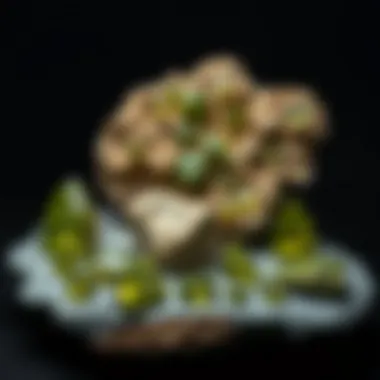
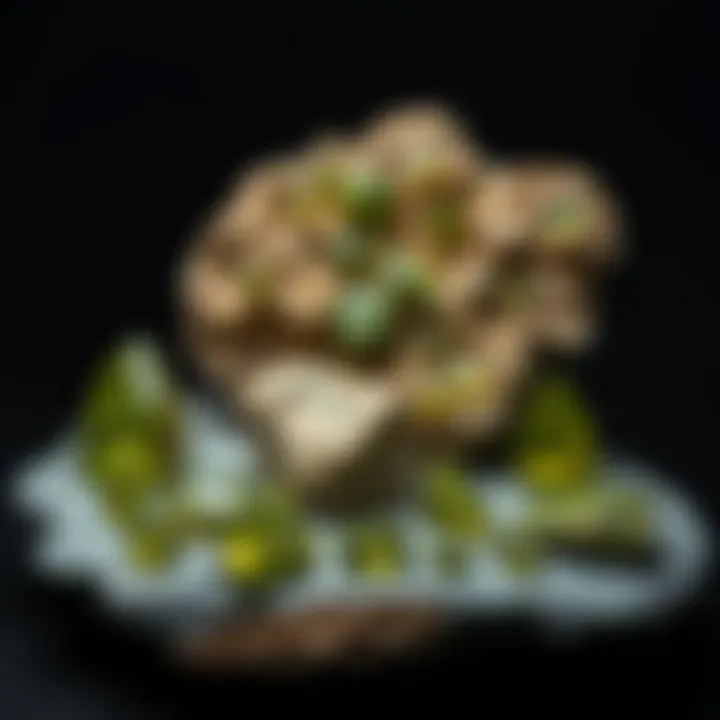
Pallasite Peridot in Culture and Mythology
Pallasite peridot isn’t just a stunning geological marvel; it also carries rich cultural and mythological significance. This extraordinary gemstone’s journey extends well beyond its scientific exploration into the realms of human belief and creativity. Understanding its role in historical context and contemporary interpretations enhances its allure and provides a deeper appreciation for collectors and enthusiasts alike.
Historical Significance
Throughout history, mesmerising stones have captivated the imagination, and pallasite peridot is no exception. Ancient cultures held a deep reverence for unique minerals, often attributing mystical properties to them. The term "peridot" itself has roots in various languages, chronicling its journey across different civilizations.
In ancient Egypt, the vibrant green color of pallasite peridot was associated with the sun god Ra. It was commonly set in gold and worn by pharaohs as a symbol of divine protection. The Egyptians equated this mineral with light, believing it could ward off nightmares and bring clarity to chaos.
In the Middle Ages, gemstones, including pallasite peridot, were believed to carry protective qualities. Many a warrior carried a piece of this mesmerizing stone, convinced it would promote victory in battle. The stone’s visualization of confidence and strength reverberated through history, making it a favorite among royalty and influential figures. Think about how they utilized this stone in armor or crowns—bringing fashion and function together in a striking display.
Modern Interpretations
Today, the captivating beauty of pallasite peridot is celebrated in various ways, translating ancient beliefs into modern narratives. For collectors, it’s not just a stone; it represents a connection to the cosmos and our planet's hidden mysteries. The modern jewelry industry has adopted it not only for its attractive aesthetics but also to evoke the charm of fortune and native heritage.
Artisans have embraced pallasite peridot in contemporary settings, crafting everything from stunning rings to intricate necklaces. Many use raw or uncut forms of the stone to highlight its original celestial origins, resonating with those who feel a connection to nature and the universe.
Moreover, in metaphysical circles, pallasite peridot is revered as a stone of transformation. It is touted to inspire new beginnings and to help its bearer navigate life transitions. The sentiment behind this belief lies deep in its cosmic heritage, suggesting it bears wisdom from the stars.
"In the depths of the earth lie stories untold, and within each pallasite peridot, a piece of that narrative shines through."
Illustrating the balance between scientific inquiry and cultural significance, pallasite peridot continues to inform our understanding of both the earth and ourselves. Whether you are a rock collector or someone touched by its mystique, appreciating its history enriches your connection to the stone—melding science with mythology in a way that’s simply enchanting.
Scientific Research on Pallasite Peridot
The field of scientific research surrounding pallasite peridot is a window into both the wonders of our universe and the intricacies of mineralogy. This gemstone, borne from the depths of meteorites, serves as a unique intersection between science and beauty, capturing the fascination of geologists, gemologists, and collectors alike. Understanding its composition, formation, and distinct properties not only informs us about the processes that govern our solar system but also about the gem's place in cultural history and modern aesthetics.
Recent Discoveries
Recent studies have shed light on several fascinating aspects of pallasite peridot. For instance, researchers have identified new mineral phases within these meteorites that were previously unknown. Techniques such as X-ray diffraction and electron microprobe analysis have provided invaluable insights into the crystallography of pallasites, revealing complex interactions between olivine and metallic phases. These findings are crucial as they deepen our understanding of how these celestial specimens form.
Another notable discovery relates to the isotopic analysis of oxygen within pallasite peridot. This analysis has shown that the mineral's origins can be traced back to differentiated asteroids, reshaping our theories about the early solar system.
- Key Highlights from Recent Discoveries:
- New mineral phases identified through advanced spectroscopic techniques
- Oxygen isotopic composition linked to differentiated asteroids
- Insights into the thermal history of meteorite parent bodies
Comparative Analysis with Other Gemstones
Understanding the unique characteristics of pallasite peridot in relation to other gemstones is not just an indulgence for collectors; it’s essential for appreciating its place within the broader landscape of mineralogy. This comparison sheds light on the distinct properties that make pallasite peridot not simply another gem, but a celestial treasure. Recognizing its uniqueness versus other gemstones can enrich one’s collecting experience and create a deeper connection to this remarkable stone.
Differences from Traditional Peridot
Traditional peridot is primarily derived from volcanic sources on Earth and is characterized by its olive-green color. While it shares a name and some colors with its extraterrestrial counterpart, pallasite peridot emerges from a dramatically different origin.
- Source: Traditional peridot, or olivine, can be found in igneous rocks, whereas pallasite peridot originates from meteoritic materials, specifically from the core-mantle boundary of differentiated asteroids. This striking origin gives pallasite its distinctive character.
- Aesthetic Qualities: Traditional peridot retains a more uniform coloring, while pallasite peridot displays a unique mix of green and brown hues mingled with metallic nickel-iron. Each specimen tells its own story through its varied patterns.
- Rarity: Pallasite peridot is considerably rarer than its earthly cousin, making it a sought-after specimen among enthusiasts. Not every day does one have a chance to own a piece of a celestial body.
These differences underscore the fact that pallasite peridot isn't just a variant; it's a tale told in crystal form—a narrative only found in meteorites rather than terrestrial gemstones that embellish our planet's landscape.
Similarities with Other Gemstone Varieties
When drawing parallels with other gemstones, it’s fascinating to see how pallasite peridot stands shoulder to shoulder with some earthly peers despite their differences.
- Color Range: Like many gemstones, pallasite peridot presents varying shades, much as sapphires do. Some sapphires showcase a spectrum from deep blue to light pastel tones, while pallasite’s colors can range from greenish to yellowish hues depending on the chemical composition and the specific meteorite from which it originates.
- Luster: Many gemstones, including garnets and emeralds, share a similar vitreous luster with pallasite, giving them a brilliant shine that catches the eye. This key similarity draws collectors and jewelers alike, seeking that glint of beauty in each stone.
- Allure in Collecting: Just as collectors are drawn to the opulence of diamonds or the uniqueness of tanzanite, they find a special allure in pallasite peridot. The story behind its extraterrestrial origins elevates its value in the collector’s world.
In essence, while pallasite peridot undoubtedly dances to its own cosmic tune, it finds kinship with the richly varied gemstone family, proving that beauty and uniqueness can be found both on Earth and among the stars.
Conclusion: The comparative analysis of pallasite peridot vis-a-vis other gemstones not only enriches our understanding of its characteristics but also allows collectors to appreciate the full spectrum of gemstone diversity. The marriage of science and aesthetics in this celestial gem represents a broader narrative in the world of mineralogy.
For further exploring the distinctive traits of gemstones, consider visiting resources like Wikipedia on Pallasite, which offers a wealth of information on this unique meteorite, or engage with registries at Reddit to see how fellow enthusiasts view pallasite peridot in light of their collections.



